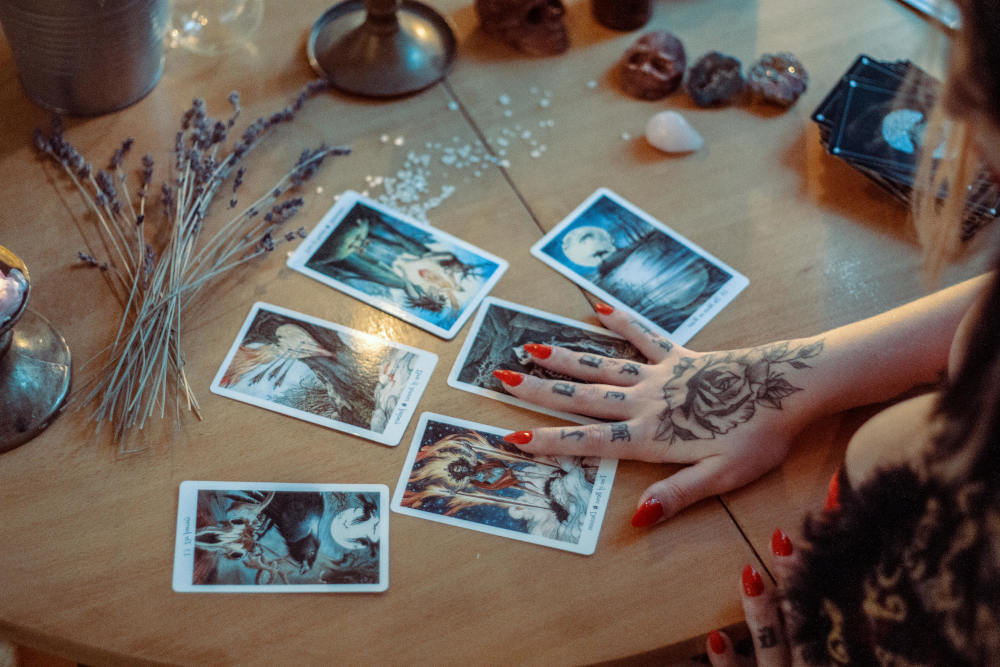
In der Welt der Wahrsagerei und spirituellen Führung werden Engelkarten und Tarotkarten von Anfängern oft synonym verwendet. Auf den ersten Blick geht es bei beiden um das Ziehen von Karten und das Interpretieren von Bedeutungen – doch unter der Oberfläche unterscheiden sie sich in Struktur, Ursprung, spirituellem Fokus und ihrer Anwendung.
Sind Engelkarten und Tarotkarten also dasselbe? Nein – aber sie verfolgen einige gemeinsame Ziele. Beide Werkzeuge zielen darauf ab, Einsicht, Klarheit und die Verbindung zu höherer Weisheit zu vermitteln, doch die Art und Weise, wie sie Botschaften übermitteln und ihr beabsichtigter Fokus unterscheiden sich erheblich .
In diesem Artikel erfahren Sie alles, was Sie wissen müssen, um den Vergleich zwischen Engelkarten und Tarotkarten zu verstehen – und welche für Sie die richtige sein könnte.
Panaprium ist unabhängig und wird vom Leser unterstützt. Wenn Sie über unseren Link etwas kaufen, erhalten wir möglicherweise eine Provision. Wenn Sie können, unterstützen Sie uns bitte monatlich. Die Einrichtung dauert weniger als eine Minute und Sie werden jeden Monat einen großen Beitrag leisten. Danke schön!
Tarotkarten verstehen
Ursprünge und Geschichte
Tarotkarten haben eine lange und komplexe Geschichte, die bis ins Europa des 15. Jahrhunderts zurückreicht, wo sie ursprünglich als Spielkarten dienten. Erst im 18. Jahrhundert begann man, sie für esoterische und spirituelle Zwecke zu verwenden. Die Struktur, die wir heute kennen – 78 Karten, unterteilt in Große und Kleine Arkana – verfestigte sich während dieser Transformation.
Zu den historischen Bezügen des Tarot zählen Astrologie, Numerologie, Alchemie und Kabbala , die alle zur symbolischen Tiefe jeder Karte beitragen.
Struktur
Ein Standard-Tarotdeck enthält 78 Karten :
-
Große Arkana (22 Karten): Repräsentiert kraftvolle Lebensthemen und spirituelle Lektionen (z. B. Der Narr, Der Turm, Die Welt).
-
Kleine Arkana (56 Karten): Unterteilt in vier Farben (Kelche, Schwerter, Stäbe und Münzen) mit jeweils 14 Karten. Diese spiegeln Alltagserfahrungen und persönliche Dynamiken wider.
Jede Tarotkarte hat sowohl aufrecht als auch umgekehrt bestimmte traditionelle Bedeutungen und wird oft in Legesystemen verwendet – bestimmten Layouts, die die Interpretation anhand der Kartenposition leiten.
Zweck und Verwendung
Tarot ist für seinen strukturierten, introspektiven Stil bekannt. Leser nutzen es, um Folgendes zu erforschen:
-
Herausforderungen im Leben
-
Persönliches Wachstum
-
Beziehungsdynamik
-
Karrierewege
-
Spirituelle Entwicklung
Aufgrund seiner Tiefe wird Tarot oft zur Selbstreflexion und Schattenarbeit verwendet – um verborgene Muster aufzudecken und unterbewusste Blockaden anzugehen.
Engelkarten verstehen
Ursprünge und Entwicklung
Engelkarten sind eine viel neuere Entwicklung und erfreuten sich erst im späten 20. Jahrhundert großer Beliebtheit. Ihre Pionierarbeit leisteten spirituelle Autoren und intuitive Heiler – allen voran Doreen Virtue , die mit ihren Kartenspielen und Workshops zur Popularisierung des Engelkartenlesens beitrug.
Engelkarten stammen aus der New-Age-Bewegung und basieren auf dem Glauben, dass Engel, Erzengel oder göttliche Wesen durch intuitive Werkzeuge Führung vermitteln können.
Struktur
Im Gegensatz zum Tarot gibt es bei Engelkarten weder eine festgelegte Kartenanzahl noch ein standardisiertes System . Die Kartendecks variieren stark in Größe, Stil und Botschaft. Manche Decks enthalten 44 Karten, andere mehr oder weniger. Jede Karte enthält typischerweise:
-
Der Name eines Engels oder spirituellen Wesens
-
Eine tröstende oder inspirierende Botschaft
-
Eine kurze Erklärung oder Bestätigung
Es gibt keine Farben, Arkana oder traditionellen Layouts – obwohl einige Leser ihre eigenen Routinen entwickeln.
Zweck und Verwendung
Engelkarten konzentrieren sich auf sanfte, liebevolle Führung aus dem spirituellen Reich. Häufige Themen sind:
-
Göttliches Timing
-
Beruhigung in schwierigen Zeiten
-
Ermutigung und Selbstwertgefühl
-
Botschaften von Schutzengeln
Sie werden häufig während der Meditation, beim Gebet oder bei Energieheilungssitzungen verwendet und viele Benutzer beschreiben die Erfahrung als pflegend und erhebend.
Hauptunterschiede zwischen Engel- und Tarotkarten
| Aspekt | Tarotkarten | Engelkarten |
|---|---|---|
| Herkunft | Europa des 15. Jahrhunderts | New-Age-Bewegung des 20. Jahrhunderts |
| Struktur | Festes 78-Karten-System | Keine feste Zahl; variiert je nach Deck |
| Symbolismus | Archetypen, Farben, Astrologie, Numerologie | Engel, göttliche Wesen, spirituelle Bestätigungen |
| Ton | Kann leicht oder intensiv sein, beinhaltet Herausforderungen | Immer positiv und sanft |
| Komplexität | Hoch – erfordert das Studium von Symbolen und Bedeutungen | Niedrig – zugänglich und intuitiv |
| Hauptverwendung | Einblicke in Lebensereignisse, inneres Wachstum, spirituelle Lektionen | Ermutigung, Trost, spirituelle Verbindung |
| Spiritueller Fokus | Innere Weisheit, Unterbewusstsein, archetypische Energien | Botschaften von Engeln oder höheren Wesen |
Sind Engelkarten einfacher zu verwenden?
Im Allgemeinen ja. Engelkarten sind einfach, beruhigend und leicht zu interpretieren . Die meisten Karten werden mit einem Handbuch geliefert, das die Bedeutung jeder Karte erklärt. Man muss sie weder auswendig lernen noch studieren, was sie ideal macht für:
-
Anfänger
-
Empfindliche Personen
-
Menschen, die tägliche Bestätigung oder emotionale Unterstützung suchen
Tarot hingegen erfordert einen Lernprozess. Leser müssen sich mit Folgendem vertraut machen:
-
78 einzigartige Karten
-
Aufrechte und umgekehrte Bedeutungen
-
Symbolische Bilder
-
Positionen und Beziehungen verbreiten
Dadurch wird das Tarot vielschichtiger und möglicherweise aufschlussreicher, aber auch einschüchternder für Anfänger.
Bieten sie die gleiche Art von Anleitung?
Nicht ganz. Beide wollen zwar Einblicke bieten, doch Ton und Tiefe der Anleitung unterscheiden sich.
Tarot: Reflektierend und transformierend
Tarot geht in die Tiefe. Es kann Wahrheiten enthüllen, denen Sie sich vielleicht nicht stellen möchten, Muster aufzeigen, die Sie durchbrechen müssen, oder Wege erhellen, die Mut erfordern. Es beschönigt nichts, sondern befähigt Sie, sich selbst zu verstehen und bewusst zu handeln .
Tarot eignet sich hervorragend für:
-
Komplexe Situationen verstehen
-
Schwierige Entscheidungen treffen
-
Innere Konflikte angehen
-
Schattenarbeit und Selbsttransformation
Engelkarten: Erhebend und beruhigend
Engelkarten geben Ihnen die Gewissheit, geliebt, beschützt und geführt zu werden. Sie erinnern Sie oft daran, zu vertrauen, sich hinzugeben und positiv zu bleiben , auch wenn das Leben unsicher erscheint.
Engelkarten eignen sich hervorragend für:
-
Tägliche Inspiration
-
Geistlicher Trost
-
Emotionale Heilung
-
Verbindung mit der göttlichen oder engelhaften Präsenz
Können Sie Engel- und Tarotkarten zusammen verwenden?
Auf jeden Fall. Viele spirituelle Praktiker und Leser kombinieren beide Kartendecks, um eine ganzheitlichere und ausgewogenere Lesung zu erhalten.
Ein gemeinsamer Ansatz:
-
Beginnen Sie mit einer Tarot-Lesung, um strukturierte Einblicke in Ihre Situation zu erhalten.
-
Senden Sie anschließend eine Engelkarte, um unterstützende Botschaften oder Ermutigung aus einer höheren Quelle zu erhalten.
Diese Kombination hilft, die geistige Klarheit des Tarot mit dem spirituellen Trost der Engelkarten zu verbinden.
Spirituelle Überzeugungen hinter jedem Deck
Tarot und das Unterbewusstsein
Tarot wird oft als ein Werkzeug angesehen, das Zugang zum Unterbewusstsein oder zum universellen Bewusstsein bietet. Es spiegelt innere Wahrheiten durch Archetypen wider, ähnlich wie Carl Jungs Theorien über das kollektive Unbewusste.
Engelkarten und göttliche Führung
Engelkarten basieren auf dem Glauben, dass es echte spirituelle Wesen – Engel, Erzengel und Geistführer – gibt, die über uns wachen . Die Botschaften dieser Karten sollen von diesen höheren Wesen stammen und durch die Intuition des Lesers übermittelt werden.
Während Tarot je nach Benutzer weltlich oder spirituell sein kann, sind Engelkarten fast immer zutiefst spiritueller oder religiöser Natur.
Häufige Missverständnisse
1. Engelkarten sind nur Tarot mit einem schöneren Namen
Falsch. Obwohl beide Systeme auf Karten basieren, unterscheiden sie sich erheblich in Struktur, Ton und Zweck . Engelkarten sind eine Art Orakelkarten und verfügen nicht über den symbolischen Rahmen des Tarots.
2. Tarotkarten sind beängstigend oder böse
Viele Menschen fürchten Tarot aufgrund von Assoziationen mit Okkultismus oder dunkler Symbolik. Tatsächlich ist Tarot weder böse noch sagt es Unheil voraus . Es spiegelt lediglich Ihren inneren Zustand und Ihren spirituellen Weg wider. Ängste rühren oft von Missverständnissen oder Mythen der Popkultur her.
3. Engelkarten sind weniger mächtig
Manche argumentieren, dass Engelkarten weniger bedeutungsvoll seien, weil sie eher „Wohlfühlkarten“ seien. Emotionale und spirituelle Heilung ist jedoch genauso wichtig wie Erkenntnis. Engelkarten mögen zwar nicht komplex sein, bieten aber einen echten Mehrwert für diejenigen, die Licht, Glauben oder Ermutigung brauchen.
Welches Deck sollten Sie wählen?
Hier sind ein paar Fragen, die Ihnen bei der Entscheidung helfen:
-
Mögen Sie Struktur, Symbolik und tiefe Einsichten ? → Beginnen Sie mit Tarot.
-
Möchten Sie tägliche Inspiration oder eine schnelle Anleitung ? → Probieren Sie Angel Cards.
-
Fühlen Sie sich zu spirituellen Wesen oder göttlicher Kommunikation hingezogen? → Engelkarten können stärkere Resonanz hervorrufen.
-
Möchten Sie intuitive Fähigkeiten entwickeln und Archetypen erforschen ? → Tarot bietet eine umfassende Grundlage.
Letztendlich sollte Ihre Intuition Ihre Wahl leiten. Wenn ein Deck – ob Tarot oder Engel – mit Ihnen in Resonanz tritt, ist es das richtige für Ihre Reise.
Abschließende Gedanken
Engelkarten und Tarotkarten sind beides kraftvolle spirituelle Werkzeuge , aber sie sind nicht dasselbe . Tarot bietet ein strukturiertes System voller Symbolik und Transformation. Engelkarten bieten sanfte, göttliche Ermutigung, die auf Liebe und Licht ausgerichtet ist.
Das eine ist nicht besser als das andere – sie dienen unterschiedlichen Zwecken . Manche Suchende bevorzugen die Tiefenwirkung des Tarots, während andere zur emotionalen Heilung auf Engelkarten zurückgreifen. Viele nutzen beides, je nach Situation oder Fragestellung.
Welchen Weg Sie auch wählen, beide Karten teilen eine zentrale Wahrheit: Sie sind nicht allein . Ob von innerer Weisheit oder Engelsbotschaften geleitet, diese Karten helfen Ihnen, die Stimme Ihres Inneren zu hören und Ihren Weg mit mehr Vertrauen, Einsicht und Klarheit zu gehen.
War dieser Artikel hilfreich für Sie? Bitte teilen Sie uns in den Kommentaren unten mit, was Ihnen gefallen oder nicht gefallen hat.
About the Author: Alex Assoune
Wogegen Wir Kämpfen
Weltweit-Konzerne produzieren in den ärmsten Ländern im Übermaß billige Produkte.
Fabriken mit Sweatshop-ähnlichen Bedingungen, die die Arbeiter unterbezahlt.
Medienkonglomerate, die unethische, nicht nachhaltige Produkte bewerben.
Schlechte Akteure fördern durch unbewusstes Verhalten den übermäßigen Konsum.
- - - -
Zum Glück haben wir unsere Unterstützer, darunter auch Sie.
Panaprium wird von Lesern wie Ihnen finanziert, die sich unserer Mission anschließen möchten, die Welt völlig umweltfreundlich zu gestalten.
Wenn Sie können, unterstützen Sie uns bitte monatlich. Die Einrichtung dauert weniger als eine Minute und Sie werden jeden Monat einen großen Beitrag leisten. Danke schön.































0 Kommentare